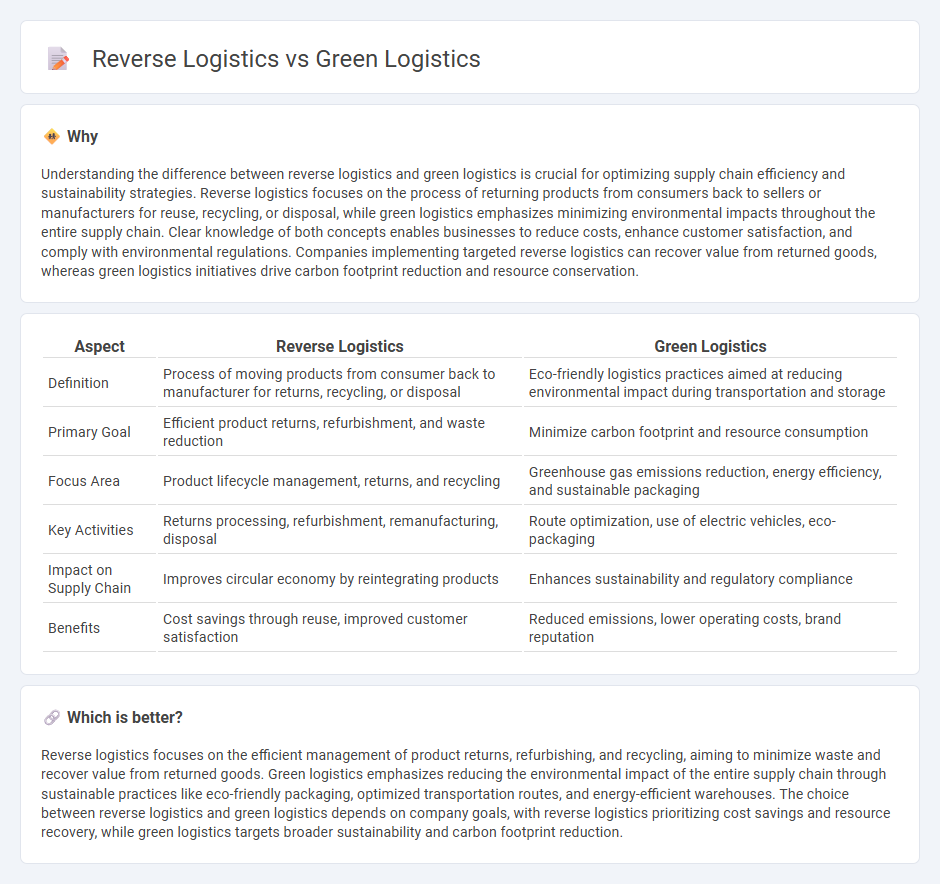
Reverse logistics focuses on the process of moving goods from their final destination back to the manufacturer for returns, repairs, recycling, or disposal, aiming to reduce waste and recover value. Green logistics emphasizes environmentally sustainable practices throughout the entire supply chain, including reducing carbon emissions, optimizing transportation routes, and using eco-friendly materials. Explore our detailed comparison to understand how these strategies enhance supply chain efficiency and sustainability.
Why it is important
Understanding the difference between reverse logistics and green logistics is crucial for optimizing supply chain efficiency and sustainability strategies. Reverse logistics focuses on the process of returning products from consumers back to sellers or manufacturers for reuse, recycling, or disposal, while green logistics emphasizes minimizing environmental impacts throughout the entire supply chain. Clear knowledge of both concepts enables businesses to reduce costs, enhance customer satisfaction, and comply with environmental regulations. Companies implementing targeted reverse logistics can recover value from returned goods, whereas green logistics initiatives drive carbon footprint reduction and resource conservation.
Comparison Table
| Aspect | Reverse Logistics | Green Logistics |
|---|---|---|
| Definition | Process of moving products from consumer back to manufacturer for returns, recycling, or disposal | Eco-friendly logistics practices aimed at reducing environmental impact during transportation and storage |
| Primary Goal | Efficient product returns, refurbishment, and waste reduction | Minimize carbon footprint and resource consumption |
| Focus Area | Product lifecycle management, returns, and recycling | Greenhouse gas emissions reduction, energy efficiency, and sustainable packaging |
| Key Activities | Returns processing, refurbishment, remanufacturing, disposal | Route optimization, use of electric vehicles, eco-packaging |
| Impact on Supply Chain | Improves circular economy by reintegrating products | Enhances sustainability and regulatory compliance |
| Benefits | Cost savings through reuse, improved customer satisfaction | Reduced emissions, lower operating costs, brand reputation |
Which is better?
Reverse logistics focuses on the efficient management of product returns, refurbishing, and recycling, aiming to minimize waste and recover value from returned goods. Green logistics emphasizes reducing the environmental impact of the entire supply chain through sustainable practices like eco-friendly packaging, optimized transportation routes, and energy-efficient warehouses. The choice between reverse logistics and green logistics depends on company goals, with reverse logistics prioritizing cost savings and resource recovery, while green logistics targets broader sustainability and carbon footprint reduction.
Connection
Reverse logistics and green logistics are interconnected through their shared focus on sustainability and waste reduction in supply chain management. Reverse logistics facilitates the efficient return, recycling, and disposal of products, minimizing landfill impact and conserving resources. Green logistics complements this by optimizing transportation, packaging, and energy use to reduce the overall environmental footprint of logistics operations.
Key Terms
**Green Logistics**
Green logistics emphasizes minimizing environmental impact through sustainable practices such as optimizing transportation routes, using eco-friendly packaging, and adopting energy-efficient warehousing. It integrates renewable energy sources and promotes the reduction of carbon emissions to enhance overall supply chain sustainability. Explore more to understand how green logistics transforms modern supply chain management for a sustainable future.
Carbon Footprint
Green logistics focuses on minimizing the carbon footprint by optimizing transportation routes, utilizing energy-efficient vehicles, and adopting sustainable packaging to reduce environmental impact. Reverse logistics complements these efforts by managing the return, recycling, and disposal of products, further decreasing carbon emissions from waste and resource consumption. Discover how integrating both strategies can significantly lower your supply chain's overall carbon footprint.
Sustainable Packaging
Green logistics emphasizes minimizing environmental impact throughout the supply chain by incorporating sustainable packaging solutions such as biodegradable materials and reusable containers. Reverse logistics focuses on the efficient return, recycling, and disposal of products and packaging to reduce waste and promote circular economy principles. Explore more about how sustainable packaging integrates with green and reverse logistics strategies to enhance environmental responsibility.
Source and External Links
What Is Green Logistics? Overview, Benefits, and Strategies - Shopify - Green logistics focuses on optimizing transportation, storage, and distribution to minimize environmental impact through strategies like route planning, load pooling, sustainable packaging, waste reduction, and eco-conscious partnerships.
What is Low-Emission Logistics & What are Its Benefits? | DHL Global - Low-emission logistics lowers emissions and waste with alternative fuels, electric vehicles, energy-efficient warehouses, and sustainable packaging, also reducing transport and packaging costs.
Green logistics: advantages and how to apply it | AR Racking Inc - Green logistics means organizing logistics with a focus on environmental footprint, improving supply chain efficiency, reducing pollution, and optimizing warehouse storage and operations for sustainability.
 dowidth.com
dowidth.com